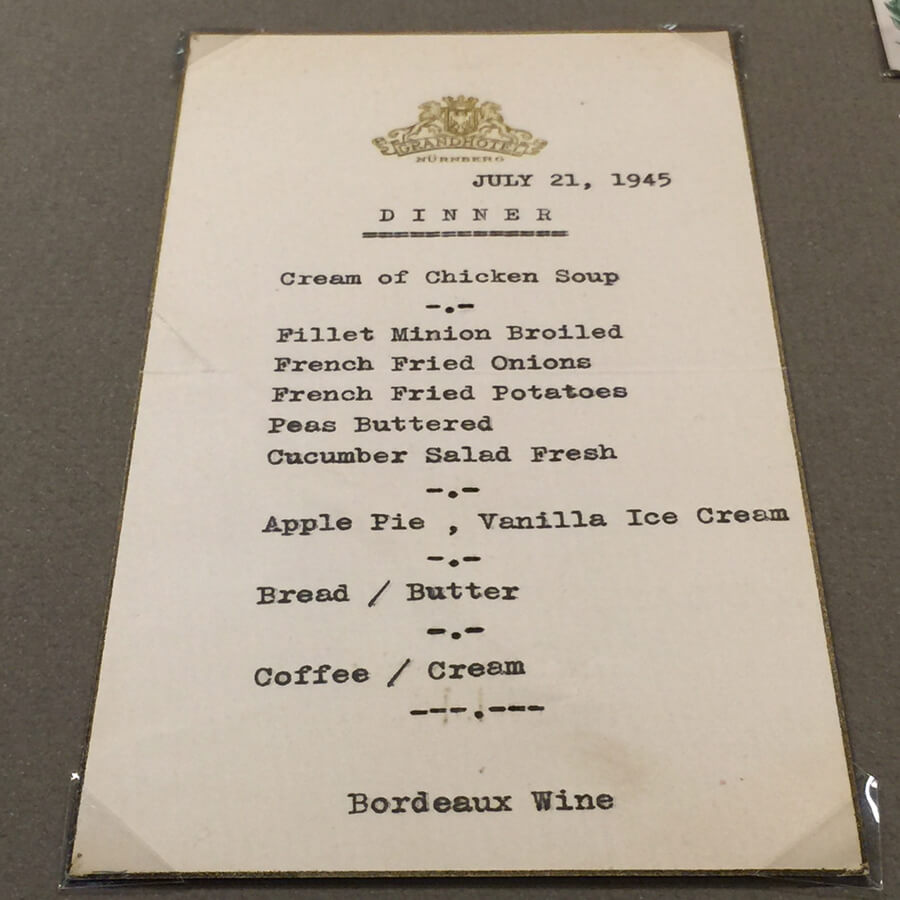MUSEUM EXHIBITIONS | January 8, 2016
12 Amazing WWII Artifacts in the Truman Collection
Rarely Viewed documents, photos and objects headed back to the Truman vault
Till We Meet Again, the Truman Library’s exhibition commemorating the 70th anniversary of the end of World War II, closed this week, but we won’t soon forget the stories behind these 12 rarely-exhibited items from the Truman collection.
WWII Service Flag
Before we tied yellow ribbons “round the old oak tree,” Americans hung service flags on walls and in windows in honor of family members serving in the armed forces. A blue star indicated active service. A gold star announced that the loved one had been killed.

Saved by a Prayer and a Spoon
This prayer book and spoon deflected a German sniper’s bullet and saved the life of Pfc. George E. Ferris. Shot near Friedewald, Germany, Ferris was carried off the battlefield by his squad leader whose helmet was shot off in the process.

British Submachine Gun
The Sten, especially the Mark II, tended to attract affection and loathing in equal measure. Its appearance and sometimes questionable reliability made it unpopular with some front-line troops. Stens could jam at inopportune moments or even discharge if dropped, but a well-maintained Sten was a devastating close-range weapon for sections previously armed only with bolt-action rifles. (Excerpted from Wikipedia)

Hitler’s Home
Occasionally, an unremarkable object brings history chillingly to life. This water utilities marker was posted at the Berghof – Adolf Hiter’s home in the Bavarian Alps. The metal sign was taken as a souvenir by advancing Allied forces.

From the Blood-Stained Soil…
The Battle of the Bulge was the final major German offensive of WWII, and American forces played a major role in the victory near Bastogne, Belgium. In gratitude, the people of Belgium created this symbolic “Urn of Earth” for President Truman. The malachite block contains soil from several battlefields on which Americans fought and died. The block sits upon a wooden swastika, symbolizing the crushing of the German forces.

The General’s Pen
Before they were political rivals, Harry and Ike were allies in the war against fascism in Europe. After signing Germany’s surrender on May 7, 1945, Dwight D. Eisenhower (D.D.E.) presented this ceremonial pen as a gift to President Truman.

Kathrine Fite: Eyewitness to History
Thanks, Till We Meet Again, for introducing us to Katherine Fite, the leading female attorney at Nuremberg. The Truman Library houses and makes available for research Katherine Fite’s papers relating, primarily, to her service as an assistant to Justice Robert H. Jackson (Fite’s main responsibility was to assist in the preparation of evidence and arguments for use in the trials of Nazi leaders). The collection includes mementos like this dinner menu, as well as the characterful and vividly descriptive letters that Fite wrote to her parents while engaged in her historic assignment.


Damning Photo
This captured German photograph showing Jews lined up against a wall prior to their execution. The image was one of many used by the prosecution at the Nuremberg Trials.

“I have returned.”
Among our favorite exhibition photos is this iconic image of General MacArthur’s return to the Philippines on October 20, 1944. Krueger’s Sixth Army had landed on Leyte, but the advance had not progressed far; snipers were still active and the area was under sporadic mortar fire. When his whaleboat grounded in knee-deep water, MacArthur requested a landing craft, but the beachmaster was too busy to grant his request. MacArthur was compelled to wade ashore. In his prepared speech, he said: “People of the Philippines: I have returned. By the grace of Almighty God our forces stand again on Philippine soil—soil consecrated in the blood of our two peoples. We have come dedicated and committed to the task of destroying every vestige of enemy control over your daily lives, and of restoring upon a foundation of indestructible strength, the liberties of your people.”

“Fat Man”
Before the world’s second atomic weapon could be detonated, this green safety plug had to be removed. The job fell to Frederick Ashworth, who removed the safety and replaced it with a red activation plug while flying in “Bock’s Car,” the B-29 that carried the plutonium weapon dropped on Nagasaki, Japan. The original target of Kokura was passed over due to low visibility caused by haze and smoke.

“The price of peace…”
On June 26, 1945, in San Francisco, the United Nations was established to maintain international peace and security and to achieve cooperation among nations on economic, social and humanitarian issues. President Truman attended and received this commemorative medallion. He later said, “We can well afford to pay the price of peace. Our only alternative is to pay the terrible cost of war.”

Explore the permanent exhibitions at the Harry S. Truman Library and Museum.
Plan your museum visit today.
Please consider making a tax-deductible gift in support of the museum exhibitions and educational experiences at the Truman Library. Thank you.


